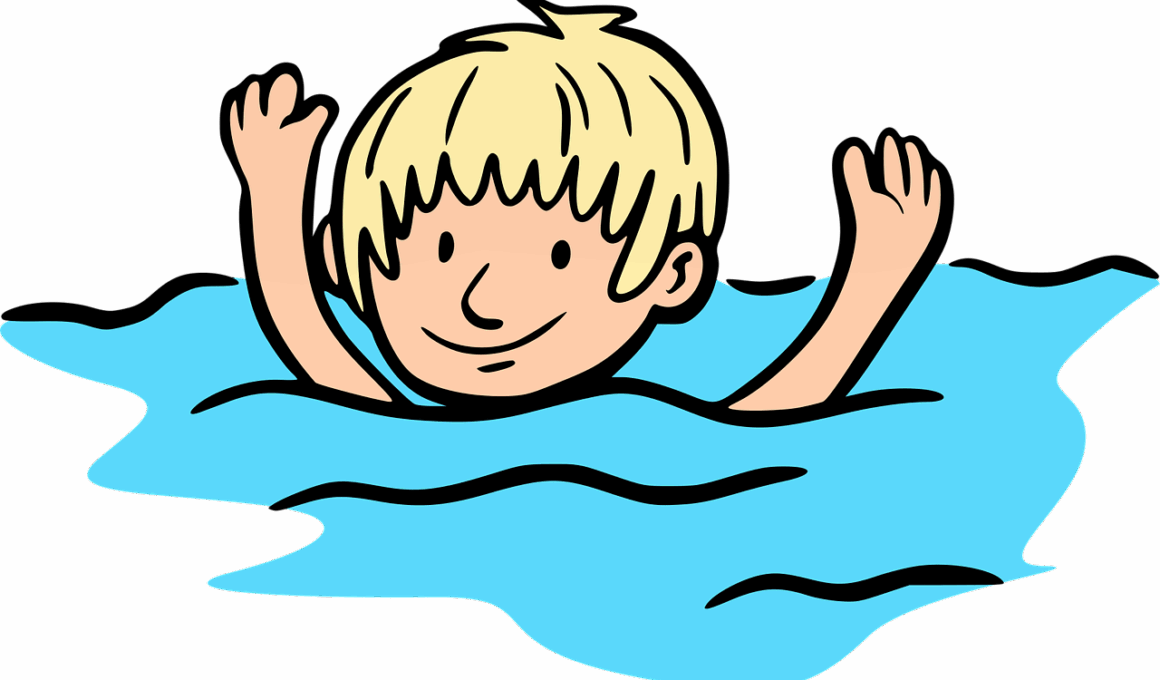The Science Behind Effective Swimming Lessons
Swimming lessons are essential for teaching individuals of all ages how to swim safely and effectively. Understanding the science behind swimming can enhance the teaching process. First, it’s essential to recognize the importance of proper technique. Proper technique ensures that swimmers use their energy efficiently, reducing fatigue, and maximizing speed. Utilizing body position, breath control, and rhythmic movements are crucial elements in swimming. Additionally, instructors should tailor their teaching methods to each student’s unique learning style. Incorporating visual aids, demonstrations, and personalized feedback can foster better understanding. Engaging students through interactive activities or games can also motivate learners and enhance retention of skills. Furthermore, incorporating safety measures during lessons is vital. This means ensuring all swimmers are aware of water conditions and emergency procedures. Creating a safe learning environment helps instill confidence in students. Regular assessments allow instructors to track progress, identify areas for improvement, and adjust instructional strategies accordingly. Thus, a systematic approach to swimming lessons balances technique, customization, interaction, safety, and assessment, promoting effective learning outcomes.
The role of water safety is critical in effective swimming lessons. Students must learn to respect water environments while mastering their swimming skills. Instructors should emphasize safety rules such as never swimming alone, utilizing swim floats, and understanding potential hazards. Safety knowledge is especially vital for children, instilling lifelong habits. Engaging students in discussions can deepen their understanding of safety measures in aquatic settings. Additionally, swimming lessons should integrate practical drills that focus on safe entry, exit, and rescue techniques. Regular practice of these skills prepares swimmers for unexpected scenarios. Furthermore, instructors can implement game-like scenarios to teach safety skills in a fun way. Creating a positive and stress-free environment encourages students to engage with materials more readily. This also builds trust between students and instructors, fostering confidence. The psychological aspects of learning are crucial too. Individuals learn better in environments where they feel safe and respected. Positive reinforcement through praise enhances motivation, boosting self-esteem. As such, educators must develop and maintain a supportive atmosphere, ensuring swimmers are both knowledgeable and vigilant. Ultimately, prioritizing safety in lessons enhances not just swimming ability but also the overall enjoyment of water activities.
Understanding the Learning Process
Grasping how individuals learn effectively is vital for swimming instructors. Each learner progresses at their own pace, and understanding these learning stages helps improve lesson efficacy. The cognitive stage is where swimmers acquire basic concepts and movements. During this period, instructors should provide clear explanations and demonstrations. Once students understand the techniques, they enter the associative stage, where they start refining their skills through practice. Here, feedback becomes essential. Constructive criticism motivates improvement and instills confidence. Additionally, the autonomous stage occurs when learners swim with automatic performance, reducing the cognitive load. Instructors should encourage independence during this stage while overseeing safety. Recognizing that some individuals may struggle with transitions between stages is key to ensuring a smooth learning experience. Each student may have unique backgrounds affecting their comfort, comprehension, and skills in water. Customizing lesson plans and recommendations for learners is essential at all times. This understanding allows instructors to differentiate instruction, making adjustments for slower learners or those advancing quickly. By addressing individual learning needs, educators can foster an inclusive environment, ensuring that every swimmer achieves personal growth while learning effectively.
Structured lesson plans play a vital role in the success of swimming education. A well-organized curriculum ensures that instructors cover essential skills progressively while building on previously learned concepts. Swimming lessons should include warm-ups and cool-downs, with attention to physical and mental preparation for each session. Incorporating different strokes and techniques is critical in developing a well-rounded swimmer. Focusing on specific skills, like buoyancy, stroke mechanics, and endurance, will further enhance student performance. In addition, integrating drills designed to improve specific skills can accelerate learning and retention. Varying practice scenarios, like swimming at different distances or in various conditions, prepares students for real-life applications. Furthermore, lessons should be designed with feedback moments to assess student understanding continually. Feedback provides opportunities for students to reflect on their performance and encourages self-assessment. Moreover, grouping students by skill level fosters productive peer interaction. More advanced swimmers can mentor beginners, promoting camaraderie and enhancing the learning experience. The importance of structured lesson planning cannot be overstated, as it not only ensures comprehensive learning but also allows swimming instructors to track progress and celebrate successes within the swimming community.
Incorporating Technology in Swimming Lessons
In today’s digital age, technology’s integration into swimming education is transforming traditional approaches. Utilizing tools like video analysis can provide swimmers with immediate feedback on their form and technique. This allows them to visually comprehend their movements and make rapid adjustments. Dedicated swimming apps can also guide workouts and measure progress over time, making practice both structured and data-driven. Virtual lessons have emerged as effective alternatives, especially for remote coaching, ensuring accessibility for all learners. Furthermore, instructors can design online platforms for sharing resources and tips that facilitate self-paced learning. Social media provides a space for sharing experiences and fostering community among swimmers. Websites hosting tutorials and forums offer additional avenues for discussion, creating collaborative learning environments. Yet, it remains equally essential to emphasize balance. While technology provides substantial benefits, too much reliance on it can detract from personal instruction. Engaging directly with learners hones interpersonal skills and encourages rapport building. Striking a balance between technology and traditional instruction leads to optimal learning outcomes. Thus, as swimming educators, adopting innovative tools while maintaining personal connections is crucial to effective swimming lessons and student success.
The importance of regular practice in swimming cannot be overstated. Frequent training sessions empower learners to become fluent swimmers. Instructors should encourage students to practice outside of scheduled lessons to reinforce skills learned. This aids in retaining knowledge and fosters muscle memory. Sets and repetition build endurance and confidence, both vital for mastering swimming. Gamifying practice sessions enhances motivation; competitions and timed races can incite excitement and encourage friendly rivalry. Setting specific goals can also help keep students focused and accountable. For instance, challenging them to improve their times or learn a new stroke introduces fun elements into practice. Additionally, family involvement can enhance swimming practice. Encouraging family members to participate can transform learning experiences. Flexible swimming options, such as open swims or family swim days, allow students to apply their skills while spending quality time with loved ones. Building this support network cultivates a positive atmosphere for learning. Thus, maintaining a regular practice schedule enriched with varied activities and support boosts swimmers’ capabilities. As technology and accessibility continue to evolve, instructors must align sporting initiatives with these developments to bolster consistent training opportunities.
Conclusion: The Impact of Effective Swimming Lessons
Effective swimming lessons leave lasting impacts on learners that extend beyond the pool. They contribute to physical fitness, mental well-being, and personal development. Learning how to swim fosters safety awareness and risk assessment abilities, crucial skills in aquatic environments. Students develop strength, endurance, and cardiovascular health while engaging in swimming activities. Additionally, swimming offers stress relief and promotes mindfulness, leading to greater overall well-being. These sessions also instill discipline and goal-setting skills, preparing individuals for life’s challenges. Swimmers learn the value of perseverance, practice, and hard work as they progress in their skills. Furthermore, achievements in swimming can cultivate self-esteem and confidence, pushing learners to excel in other aspects of life. Finally, fostering a sense of community within swimming groups encourages social bonding, teamwork, and mutual support. Consequently, as instructors strive to create effective swimming lessons by focusing on technique, safety, and practice, they also contribute significantly to enhancing the quality of life for their students. Emphasizing these principles ensures that swimming remains an enjoyable, purposeful activity that nurtures personal growth and lifelong love for water activities.
The impact of effective swimming lessons extends far beyond the physical activity involved. Students often form emotional connections to their swimming experiences. Masters of sports psychology emphasize that positive reinforcement plays a critical role. This means utilizing praise, encouragement, and enjoyable activities promotes a favorable learning atmosphere. As students yearn for the thrill of improvement and mastery, instructors can strategically enhance their engagement. Furthermore, observing progress fosters determination and commitment within swimming lessons. Each achieved goal reinforces the habit of persistent effort, cultivating a growth mindset. This mindset allows learners to appreciate setbacks as opportunities for further learning rather than obstacles. Instructors can leverage the community aspect of group lessons, enhancing social dynamics by encouraging friendships among participants. Shared experiences contribute significantly to motivation levels. When students cheer each other on, a sense of belonging develops, ensuring that they feel valued. Integrating social activities or team-building exercises can fortify camaraderie and excitement. Additionally, arranging for events such as swim meets allows students to publicly showcase their skills. Ultimately, effective swimming lessons create enjoyable and impactful experiences, promoting holistic development for young swimmers in aquatic environments.


